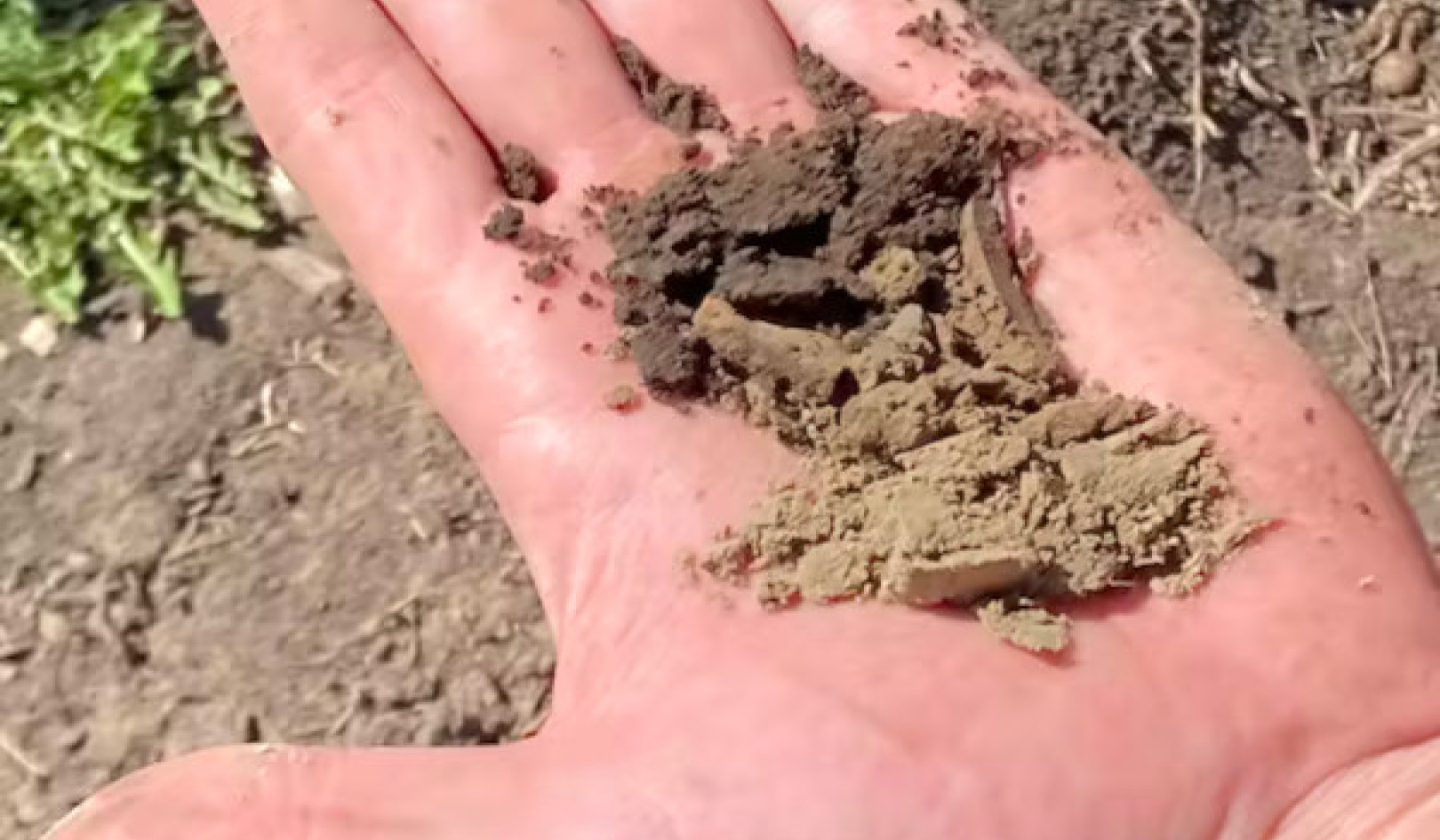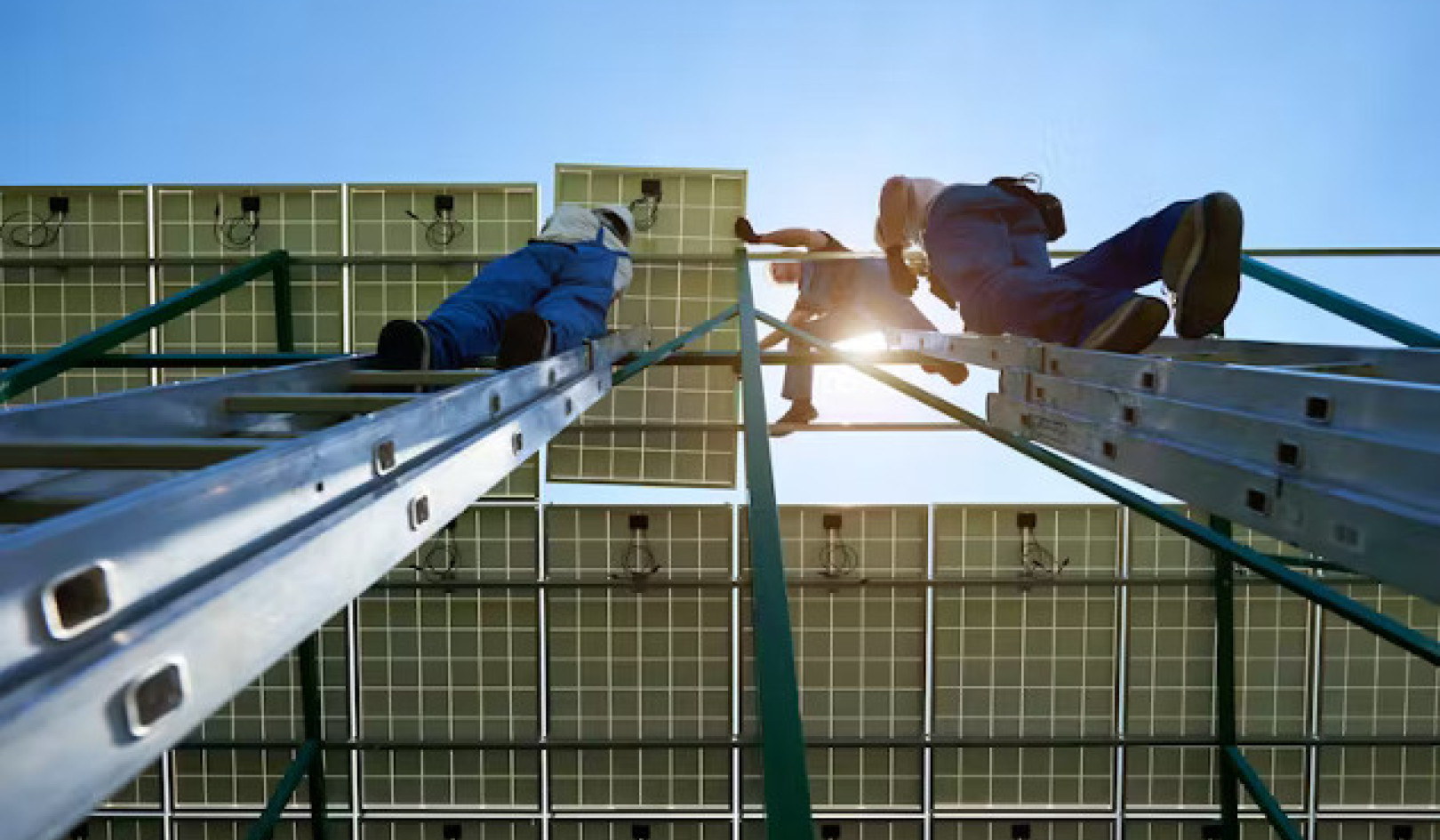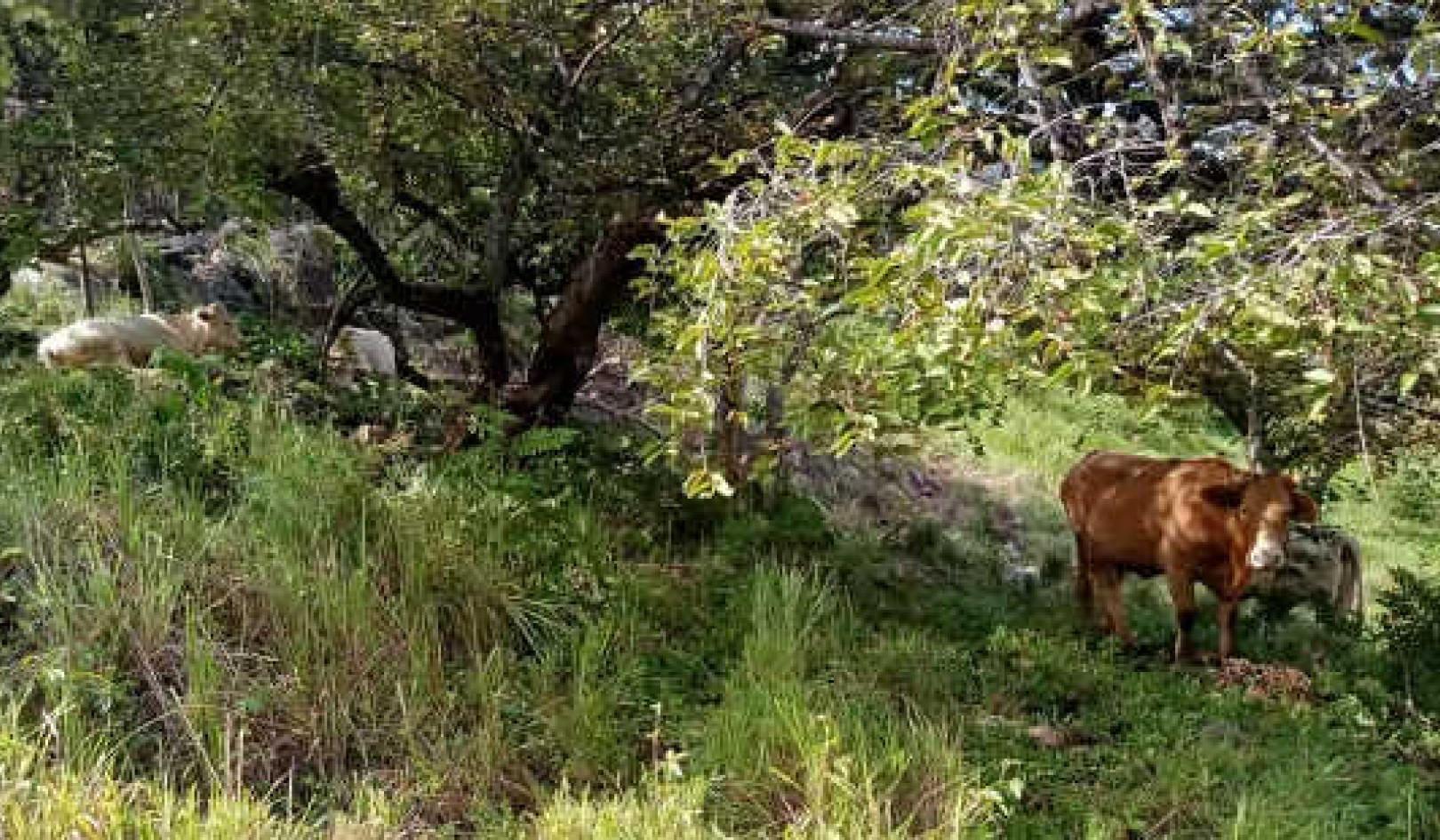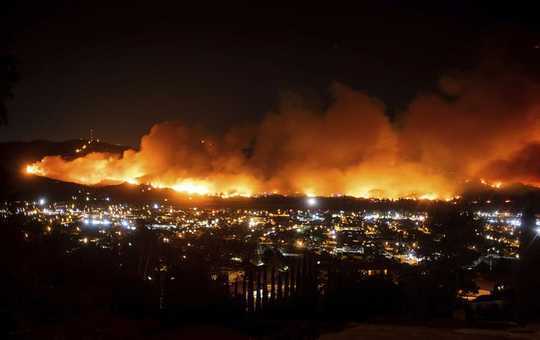
The Maria Fire billows above Santa Paula, California on Oct. 31, 2019. AP/Noah Berger
The Golden State is on fire, which means that an idea of American utopia is on fire, too.
Utopias are the good places of our imagination, while dystopias are the places where everything goes terribly wrong, where evil triumphs and nature destroys her own. Frequently utopias and dystopias are the same place, because perfection may not be possible without someone suffering.
Ursula LeGuin writes about this paradox in “The Ones Who Walk Away from Omelas,” a story about the moral dilemma of living in a city called Omelas whose prosperity is made possible by one child’s pain. As the story’s title makes clear, most people don’t walk away from the beautiful place, even when its secret is known.
California often finds itself the Omelas of the American imagination. For some, it’s the beautiful place where having it all means shafting someone else, as in Roman Polanski’s “Chinatown,” about Los Angeles’ theft of water from the Owens Valley. Or as in the magical theme park, Disneyland, which substantially underpays some of its workers.
The novelists Octavia Butler, Edan Lepucki, Karl Taro Greenfeld, Paolo Bacigalupi and Claire Vaye Watkins are among the many who have imagined the Golden State as a dystopian novel. In their novels, California is either on fire, in extreme drought or both. They all picture California’s descent as a combination of climate crisis and social unrest.
For these authors, climate change hints at the dark secret of the perfect place, of bad decisions that all America shares. Their novels suggest that if California looks like a dystopia before other American places, that’s because it’s often in the lead.
“California is America fast-forward,” sociologist Manuel Pastor says.
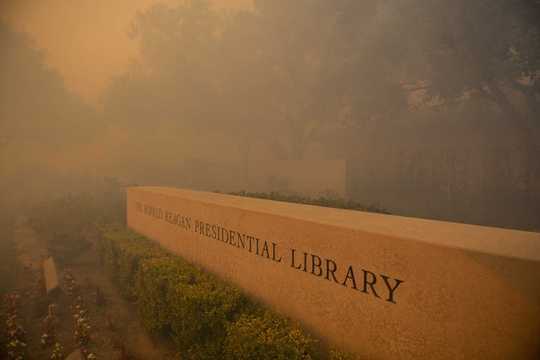
Building next to – and in – wildlands increases the risks of a fire. Here, smoke engulfs the Ronald Reagan Library during the Easy Fire, Wednesday, Oct. 30, 2019, in Simi Valley, California. AP/Christian Monterossa
‘Ecology of fear’
The wildfires that ravage California light up America’s screens with terror. Suburban homes are stripped to their foundations; Samaritans lead horses from burning barns.
The historian Mike Davis reminds us that California has long seemed an “ecology of fear” for Euro-Americans. Settlers from Northern Europe and the East Coast did not understand Southern California’s climate, which is prone to unpredictability and drought.
“It is Walden Pond on LSD,” Davis writes, meaning that it is a psychedelic version of American nature spots like Walden Pond, in New England.
The unfamiliarity of California’s climate led to poor decisions about where to build from the start. Now Californians, like most western Americans, live too close to their wildlands, which are drying into tinderboxes.
“In the United States, there are now more than 46 million single family homes, several hundred thousand businesses, and 120 million people living and working in and around the country’s forests,” writes the journalist Edward Struzik, in “Firestorm,” his book about “how wildfire will shape our future.”
America has created the combustible environment called intermix, where residential and commercial uses spill into wildlands. America craves inexpensive electricity, too, which means that overhead power lines run through forests and chaparral.
Overhead lines have sparked some of the worst recent fires in California and other American places like New Mexico and Tennessee.
California utility company PG&E estimates the cost for converting overhead to underground lines at US$3 million per mile. While cost estimates vary, such a project surely will be expensive and might take a century to complete.
Overhead infrastructure wasn’t made for extreme weather, like the estimated 80 mph winds that inspired a rare “extreme red flag” warning in Southern California.
Pleasure in the state’s demise
On fire, California is a dystopian novel that the rest of America reads avidly, and at times with schadenfreude, that feeling of joy that a person may take in another’s suffering.
California ranks as one of the happiest states in the U.S., at number 13. But California came in last in a 2012 poll on which states Americans like.
Maybe it’s the happiness that annoys others, which some perceive as phony (“tofu,” “silicone” and “dyed hair,” said Sen. Ted Cruz in 2018, about what is wrong with California).
When California was on fire in 2018, with thousands missing and dozens dead, President Donald Trump tweeted that the state mismanaged its forests. He tweeted the same thing during the recent fires, with more force. Schadenfreude? Arguably, the nation is struggling to address the fire challenges of the intermix, and California is ahead of the rest.
California supposedly is most hated by conservatives. But it nurtured the careers of conservative icons Ronald Reagan and Rush Limbaugh, plus a pair of conservative ballot measures, Prop 13 and Prop 187, that cut taxes as well as services to immigrants.
It is also the birthplace of modern progressive movements, from the United Farm Workers to environmentalism. California has been a seedbed of American political passions, to the Right and Left. Perhaps that’s why it arouses passion – and envy.
Confronting the secret
Dystopian thought criticizes what it loves in an attempt to make it better.
If California is living a dystopian novel, it is also a first responder to the fires of a changing planet.
Some of the state’s utility companies are getting smarter about infrastructure fixes. Evacuations are going better in the places where evacuations happened before. Californians voted in a landmark cap-and-trade bill to curb greenhouse gas emissions, and now they are trying to improve on it.
The state’s climate policy and renewed support for investment in public education signal that it is getting past the nation’s racial generation gap, where older white voters don’t see themselves in a demographically browner youth and resist funding them.
Living in Omelas means either compromising with injustice or learning how to make the world better before others even know that it’s broken.
Stay tuned.
About the Author
Stephanie LeMenager, Professor of English Literature, University of Oregon
This article is republished from The Conversation under a Creative Commons license. Read the original article.
Related Books
Life After Carbon: The Next Global Transformation of Cities
by Peter Plastrik , John Cleveland The future of our cities is not what it used to be. The modern-city model that took hold globally in the twentieth century has outlived its usefulness. It cannot solve the problems it helped to create—especially global warming. Fortunately, a new model for urban development is emerging in cities to aggressively tackle the realities of climate change. It transforms the way cities design and use physical space, generate economic wealth, consume and dispose of resources, exploit and sustain the natural ecosystems, and prepare for the future. Available On Amazon
The future of our cities is not what it used to be. The modern-city model that took hold globally in the twentieth century has outlived its usefulness. It cannot solve the problems it helped to create—especially global warming. Fortunately, a new model for urban development is emerging in cities to aggressively tackle the realities of climate change. It transforms the way cities design and use physical space, generate economic wealth, consume and dispose of resources, exploit and sustain the natural ecosystems, and prepare for the future. Available On Amazon
The Sixth Extinction: An Unnatural History
by Elizabeth Kolbert Over the last half-billion years, there have been Five mass extinctions, when the diversity of life on earth suddenly and dramatically contracted. Scientists around the world are currently monitoring the sixth extinction, predicted to be the most devastating extinction event since the asteroid impact that wiped out the dinosaurs. This time around, the cataclysm is us. In prose that is at once frank, entertaining, and deeply informed, New Yorker writer Elizabeth Kolbert tells us why and how human beings have altered life on the planet in a way no species has before. Interweaving research in half a dozen disciplines, descriptions of the fascinating species that have already been lost, and the history of extinction as a concept, Kolbert provides a moving and comprehensive account of the disappearances occurring before our very eyes. She shows that the sixth extinction is likely to be mankind's most lasting legacy, compelling us to rethink the fundamental question of what it means to be human. Available On Amazon
Over the last half-billion years, there have been Five mass extinctions, when the diversity of life on earth suddenly and dramatically contracted. Scientists around the world are currently monitoring the sixth extinction, predicted to be the most devastating extinction event since the asteroid impact that wiped out the dinosaurs. This time around, the cataclysm is us. In prose that is at once frank, entertaining, and deeply informed, New Yorker writer Elizabeth Kolbert tells us why and how human beings have altered life on the planet in a way no species has before. Interweaving research in half a dozen disciplines, descriptions of the fascinating species that have already been lost, and the history of extinction as a concept, Kolbert provides a moving and comprehensive account of the disappearances occurring before our very eyes. She shows that the sixth extinction is likely to be mankind's most lasting legacy, compelling us to rethink the fundamental question of what it means to be human. Available On Amazon
Climate Wars: The Fight for Survival as the World Overheats
by Gwynne Dyer Waves of climate refugees. Dozens of failed states. All-out war. From one of the world’s great geopolitical analysts comes a terrifying glimpse of the strategic realities of the near future, when climate change drives the world’s powers towards the cut-throat politics of survival. Prescient and unflinching, Climate Wars will be one of the most important books of the coming years. Read it and find out what we’re heading for. Available On Amazon
Waves of climate refugees. Dozens of failed states. All-out war. From one of the world’s great geopolitical analysts comes a terrifying glimpse of the strategic realities of the near future, when climate change drives the world’s powers towards the cut-throat politics of survival. Prescient and unflinching, Climate Wars will be one of the most important books of the coming years. Read it and find out what we’re heading for. Available On Amazon
From The Publisher:
Purchases on Amazon go to defray the cost of bringing you InnerSelf.comelf.com, MightyNatural.com, and ClimateImpactNews.com at no cost and without advertisers that track your browsing habits. Even if you click on a link but don't buy these selected products, anything else you buy in that same visit on Amazon pays us a small commission. There is no additional cost to you, so please contribute to the effort. You can also use this link to use to Amazon at any time so you can help support our efforts.





















